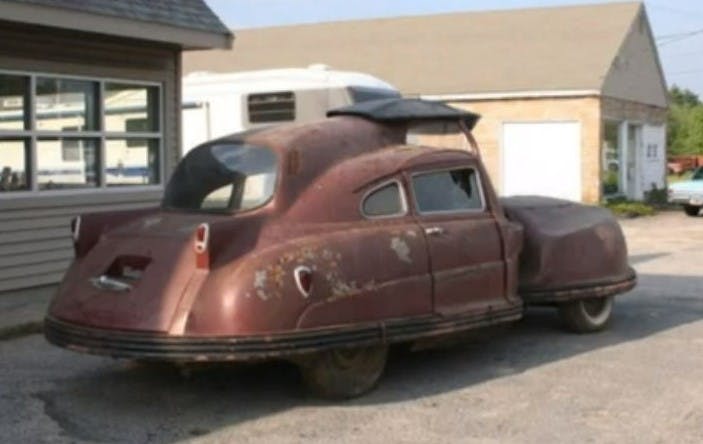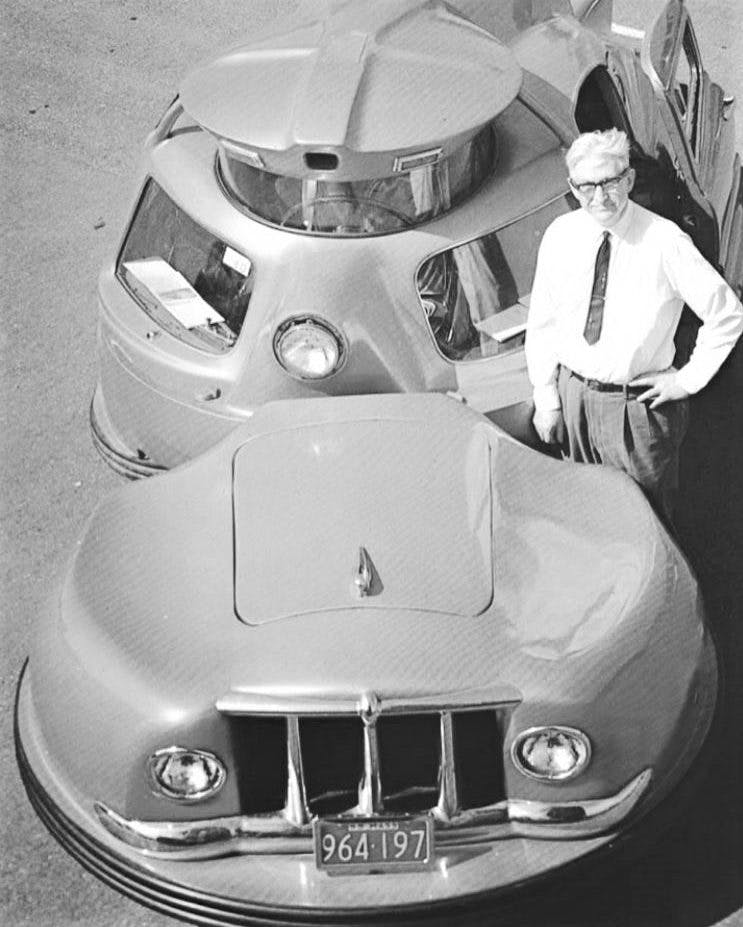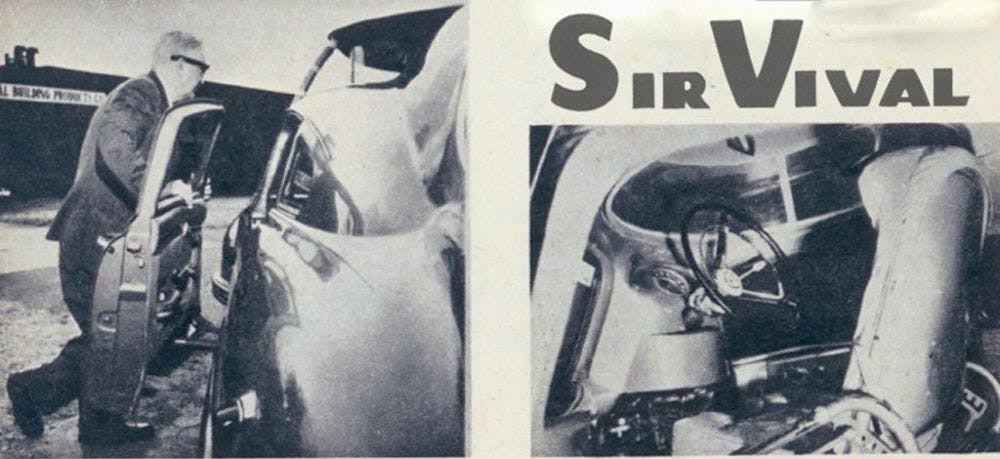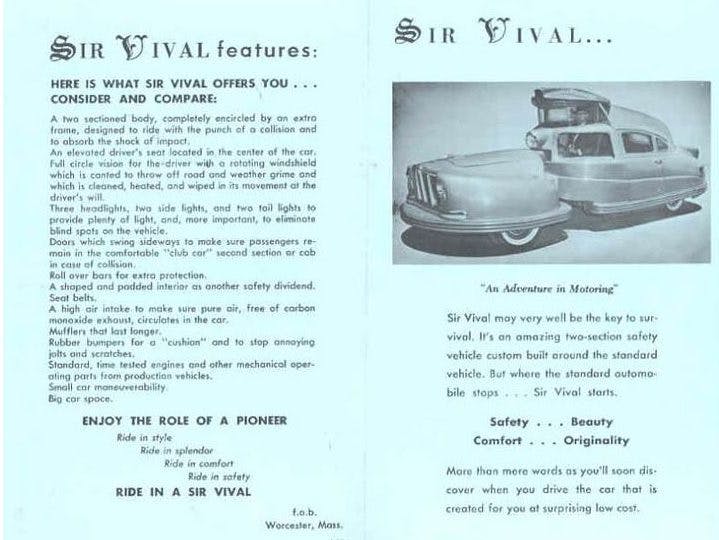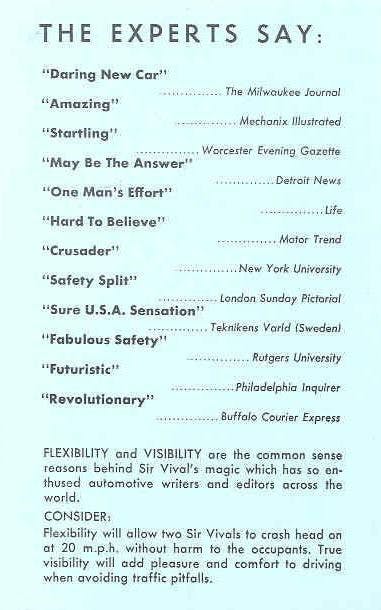This center-hinged car was all about Sir Vival in 1958

With a name as noble as its pursuit to become the world’s safest automobile, the 1958 Sir Vival was a car ahead of its time. It was so far ahead of its time, in fact, that the public never considered it more than an oddity. Created over a 10-year period in Worcester, Massachusetts, the alien-looking, two-sectioned car was Walter C. Jerome’s attempt to correct what he felt was Detroit’s lack of concern for passenger safety.
Jerome, a graduate of Northeastern University’s College of Engineering, grew concerned about highway safety statistics that showed nearly every automobile that was built ultimately injured at least one person before it reached the scrap heap. Considering that human error was the cause of most accidents, Jerome’s goal was two-fold: to build the safest automobile possible while anticipating the most common driver errors.

Starting with a 1948 Hudson that he purchased from Donald Moore’s Bellingham Motors, Jerome drew up blueprints and enlisted the help of students at the Worcester Boys’ Trade School. By the time the project was considered complete a decade later, it no longer looked like a Hudson—or any other automobile on the street. The “Sir Vival’s” most distinctive feature was its two-part construction: The engine and front wheels were separated from the main passenger cab and rear wheels via an articulated universal joint. Jerome surmised that the two-section design would better disperse the impact of a collision and prevent the engine from slamming into the passengers in a head-on crash.
The driver sat in the center of the second compartment, three feet above the rest of the car inside a driver’s turret. Thanks to a cylindrical glass enclosure, the drive had a full 360-degree view from this elevated seat. The Sir Vival also boasted many of the safety features that would later become standard equipment, including seat belts, rubber bumpers, and side lights. In addition, the Sir Vival was front-wheel drive and had front headlights that moved with the steering inputs. The passenger compartment featured a third headlight, a built-in roll cage, and sliding side doors.

The Sir Vival wasn’t exactly pretty to look at—especially since it was born during perhaps the most stylish period in the history of automobiles—but Jerome was certain that the public would embrace the safety features. It didn’t. He traveled around the country for many years, including the 1964 New York World’s Fair, showing off the car and trying to entice investors to join his venture. He also managed to drum up a fair amount of publicity, including features in Life and Motor Trend, and a 1959 cover story in Mechanix Illustrated, although it appears that the magazine tried to spruce up the car’s actual brownish-red color by swapping it for a green, white, and red paint job.

Jerome handed out pamphlets that explained the Sir Vival’s finer points, and he also took out advertising in magazines. He did not undersell it.
“SUDDENLY EVERYTHING ELSE IS OBSOLETE!” one ad shouts. “A bold claim, we know, but we’ll let you judge after viewing SIR VIVAL. We believe it to be a rare blend of exciting design and solid engineering, adding up to the safest automobile ever built. It’s the solution for survival.” After listing the car’s safety features, the ad concludes, “These are more than glib phrases, for each and every feature of this motor vehicle was designed with you in mind. We believe it is possible to combine beauty with safety …”
Jerome told Mechanix Illustrated that he planned to build 10 to 12 Sir Vivals a year and sell them for $10,000 each—about $98,000 today—more than twice the cost of a new 1958 Cadillac Sixty-Two sedan. Jerome ultimately hoped to crank out one car a day, but in the end, he built just one car: the prototype.
After Jerome’s death in the early 1970s, the Sir Vival ended up back where it started: at Donald Moore’s Bellingham Motors, where it was placed in storage. It’s been there ever since and is now closely guarded by Moore’s son, Edward.
“I’ve had a few people try to get Sir Vival from me,” Moore told Hemmings last fall. “I just tell them all that it’s not for sale. I really haven’t decided what to do with it, but I probably won’t restore it.”
Whether or not Moore restores it, we sure would love to see the Sir Vival run again, so that it can once again receive the attention and appreciation that Jerome thought it deserved.
Enjoy the role of a pioneer!
Ride in style,
Ride in splendor,
Ride in comfort,
Ride in safety.
Ride in a Sir Vival.

